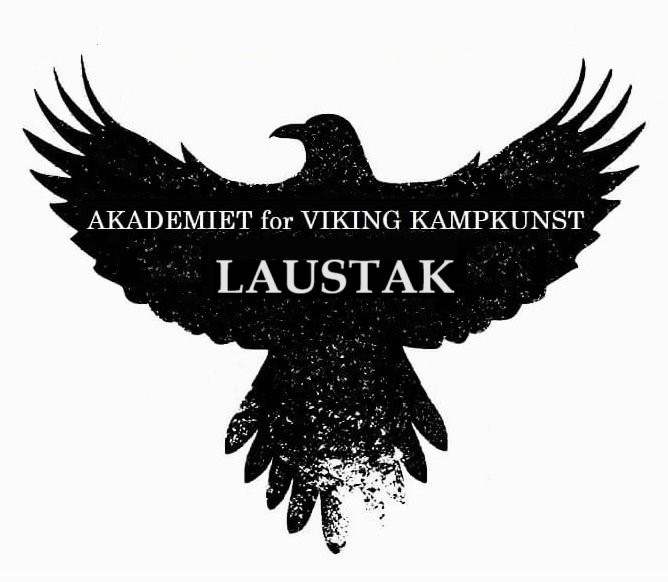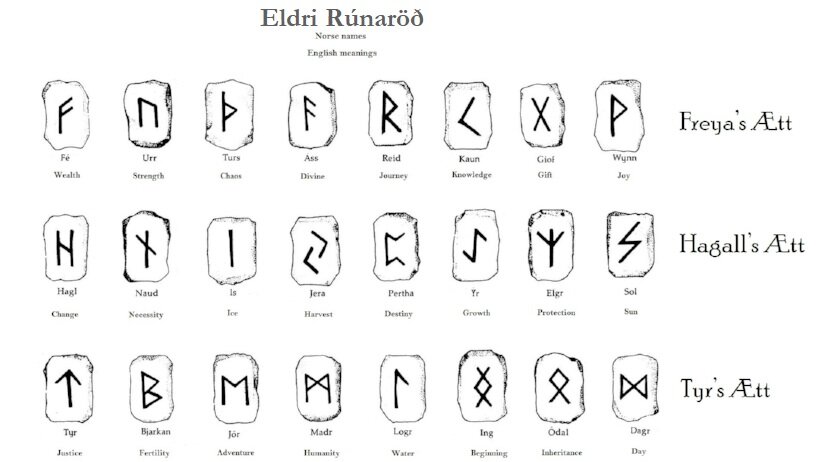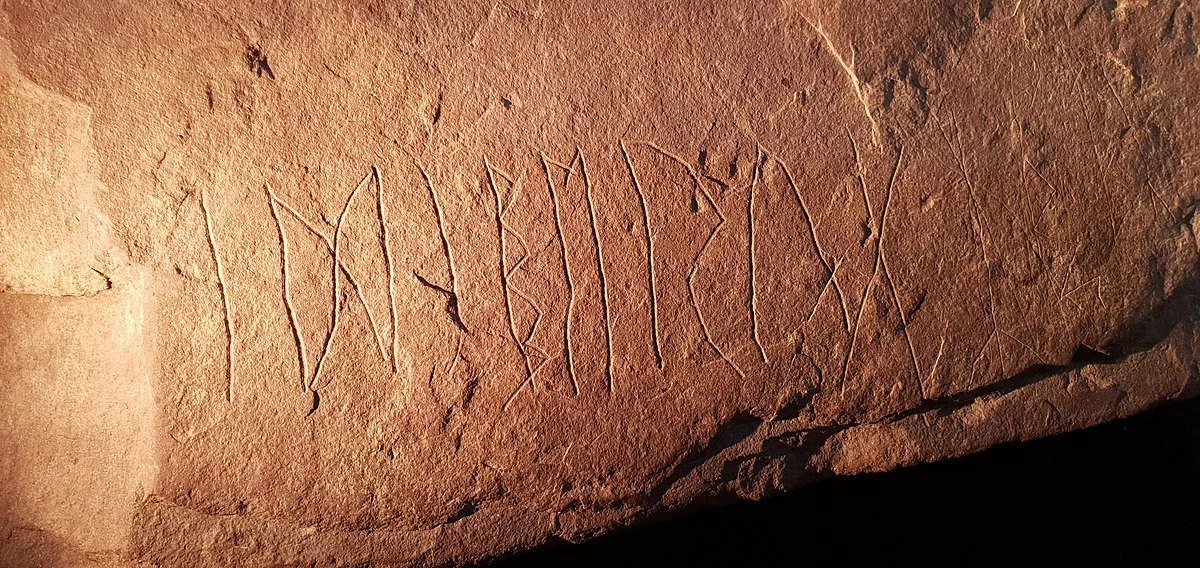VIKING RUNES by Tyr Neilsen
/The Old Norse word Rún means "secret", and runes were thought of by Vikings as sacred secrets, and a way of interacting with both the living and the spirit world.
Hávamál - verse 80
When searching for
Answers in the runes
Which were created by the gods
And written by Odin
It is best to reflect
Over the meaning
According to legend, the Norse god Odin speared himself to a tree, in a self-sacrificial attempt to receive sacred knowledge. At the end of his ‘shamanistic journey’, hanging suspended for nine windy nights, Odin learned the mysteries of the runes, which he then passed on to his people.
Hávamál - verse 139 (as told by Odin)
No bread was I given nor drink from a horn,
downwards I peered,
I took up the runes,
screaming I took them,
then I fell back.
Since the Vikings believed the runic letters to be a gift from Odin, they treated them with great reverence. Belief in the divine origin of the runes meant that runes possessed magical powers.
The Vikings are often portrayed as illiterate and uncultured barbarians who were more interested in plunder than in wisdom. This is very far from the truth. The Vikings left behind a great culture recorded in a number of manuscripts written on vellum, which are both rich in wisdom and artistic achievement. These documents were based on the earlier Viking oral tradition and information Vikings had carved in stone, wood, bone and metal.
What was carved in these hard materials were enigmatic letters made up of straight lines. Each letter, called a rune, had its own unique sound that was said, or sung, to represent them. These sounds could be used singularly as a chant, or together as a chant. These chants, or rune-songs, are known as Galdr, which means spell and incantation in Old Norse, and any serious use of runes would include them.
The first collection of 'Viking runes' is called Eldri rúnaröð, the Elder rune-row, which had 24 runes. These were the runes used by the Norse people from the 2nd to 9th century. At some point in time the Elder rune-row was arranged into three groups of eight runes called an Ætt, meaning clan. Each Ætt had 8 runes, and each Ætt were ruled over by their own particular spirit or Norse God. Freya is the Norse goddess of fertility. Tyr is the Norse god of war and justice. There is much discussion about who or what Hagall is regarding the rune-row.
From about 9th century onward, ‘Viking’ runes changed to Yngri rúnaröð, the Younger rune-row, which had 16 runes, and were called the Scandinavian runes. In Europe they were known as the "alphabet of the Norsemen" and were studied in the interest of trade and diplomatic contacts. The "alphabet of the Norsemen" is referred to as Abecedarium Nordmannicum in Frankish Fulda and Ogam Lochlannach "Ogham of the Scandinavians" in the Book of Ballymote. The "Lochlanns" may have been a generic description for both Norwegian warriors ‘Vikings’ and insular forces of Norse descent based in the Norðreyjar, the Northern Isles, off the north coast of mainland Scotland.
We associate runes used for writing as letters of an alphabet. The Viking ‘alphabet’ has been called 'Futhark', based on the first 6 rune letters, which look like the letters f,u,t,h,a,r, and k.
Viking rune letters can be used to spell out words. The illustration above shows the corrolation between older Viking runes and Alphabet letters.
THE SECRET OF THE RUNES
We know of the meaning of Viking rune letters from Viking Rune Poems. These poems list the rune letters and provide an explanatory poetic stanza for each rune letter/word. There are three different poems that have been preserved:
The Norwegian Rune Poem is a 17th-century copy of a destroyed 13th-century manuscript.
The Icelandic Rune Poem is recorded in four Arnamagnæan manuscripts, the oldest of the four dating from the late 15th century. This has been called the most systemized of the rune poems (including the Abecedarium Nordmannicum) and has been compared to the ljóðaháttr verse form.
The Old English rune poem is dated to the 8th or 9th century.
The Icelandic and Norwegian rune poems list 16 Younger rune-row runes, but the Old English rune poem has 29 Anglo-Saxon runes. Each poem differs in poetic verse, but they contain numerous parallels between one another.
The rune poems and old texts, give sets of associations for the runes, but the meanings of the runes are quite fluid. Each rune letter has an association, meaning, or several meanings, connecting a variety of things including: objects, creatures and archetypal processes, feelings, experiences, and spirits.
Rune writing was a very important skill for the Vikings, and runic inscriptions are found on artifacts including jewelry, amulets, tools, weapons, calendars and stones. But rune letters were not only used for writing, they were also used to tell fortunes, cast spells, provide protection and spiritual purposes.
The Poetic Edda mentions the magical significance of the runes. Verses 80, 111, 137, 143 and 158 of the Hávamál are about Odin mentioning the runes in contexts of divination.
The most prolific source for runic magic in the Poetic Edda is the Sigrdrífumál, where the Valkyrie Sigrdrífa (Brynhild) gives advice on the magical properties of runes. Some of these are:
"Victory runes" (stanza 6, referring to the Tyr rune to be carved on the sword hilt) Ølrunar "Ale-runes" (stanza 7, a protective spell against being bewitched by means of ale served by the hosts wife) Biargrunar "birth-runes" (stanza 8, a spell to facilitate childbirth)
Brimrunar "wave-runes" (stanza 9, a spell for the protection of ships, with runes to be carved on the stem and on the rudder)
Limrunar "branch-runes" (stanza 10, a healing spell, the runes to be carved on trees "with boughs to the eastward bent")
Malrunar "speech-runes" (stanza 11, refers to a spell to improve rhetorical ability at the thing)
Hugrunar "thought-runes" (stanza 12, discusses a spell to improve wit)
SWORD RUNES
Vikings believed that runes had magical qualities that were very valuable to a warrior, such as protecting a warrior in battle or at sea, cursing or guarding against threats, and curing illnesses. The Ansuz and Tiwaz runes in particular seem to have had magical significance in the early (Elder Futhark) period.
Runes inscribed on a sword blade gave it magic power. A warrior who knew the secret of the runes could strengthen his own blade or blunt his enemy’s weapons. Viking warriors customarily carved the runic letter for Tyr, the Norse god of war, onto their swords and shields. In the Poetic Edda, the Sigrdrífumál mentions "victory runes" which should be carved on a sword: "some on the grasp and some on the inlay, and name Tyr twice".
The Seax of Beagnoth (also known as the Thames scramasax) is a 10th-century Anglo-Saxon seax (single-edged knife), found in the River Thames, England, in 1857. It is a prestige weapon, decorated with elaborate patterns of inlaid copper, bronze and silver wire. On one side of the blade is the only known complete inscription of the twenty-eight letter Anglo-Saxon runes.
RUNESTONES
Viking runes were inscribed into large freestanding rocks or boulders called Runestones. Runestones were often decorated with inscribed intricate Norse patterns and painted in black, blue, red and white paint.
Many Rune-stones served as spiritual stones for sacred ceremonies. Runestones served as spiritual commemorations for the dead. Runestones also served as memorials to honor men and women, or to document how much land the deceased Viking had owned and listing relatives who would likely inherit that person's estate.
Left: The runestone of King Harald Bluetooth, carved around A.D. 965 in Jelling, Denmark. Middle: The larger Jelling stone. Right: Deatail showing rune inscription concerning Harald
When the seafaring Vikings traveled to faraway lands, they brought their system of writing with them, and left behind runic inscriptions in paces as distant as Greenland and Byzantium.
Wherever they went, Vikings turned to runes to express both the poetic and the plain, inscribing them on everything from great stone monuments to common household items. Rune carvings varied from "Listen, ring-bearers, while I speak of the glories in war of Harald, most wealthy" to "Rannvieg owns this box".
The world’s oldest runestone is the Svingerud Runestone, which dates back to the Roman Iron Age, c. 1–250 CE. Found in Ringerike, Norway, in 2021, the Svingerud Runestone, is a flat, square block of brownish sandstone, measuring 31cm by 32cm (12.2in by 12.6in). Inscribed on the stone are some of the oldest runic inscriptions ever found.
The runestone’s inscriptions are up to 2,000 years old, and date back to the earliest days of runic writing. The most notable inscription is the name idiberug (or possibly idiberun) which could be interpreted as one of several names, including Idibera, Idibergu, or the family name Idiberung.
The first three letters of the Elder rune-row, ᚠ (f), ᚢ (u) and ᚦ (th), are also found on the stone.
RUNE CARVINGS
Runes were carved into many objects, such as staves, staffs. A Rune Stave was found in the Norwegian Oseberg burial mound, alongside the two women who were buried there in the year 834. The round birch stave is 2,5 meters long, 8 cm round in the middle and 2-3 cm at the ends. On one end of the stave there is a carved ornament and runes reading “litiluism”.
The runic inscription is difficult to decipher. Sophus Bugge has interpreted it as “lítil-viss (er) madr” which translated means “Man knows little”. Another interpretation is that it reads “litill vissm”, which translated reads “(Although) I am small I am wise”. A third interpretation is “litil vés m” meaning “I (who am) small am the sanctuary”.
Runic calendar inscribed in whale bone
RUNIC CALENDAR
A Runic calendar is a calendar that correlates to the Sun and the Moon. Runic calendars were written on parchment or carved onto staves of wood, bone, or horn. The oldest known runic calendar is the Nyköping staff from Sweden, from the 13th century. Most of the several thousand which survive are wooden calendars dating from the 16th and the 17th centuries.
A primstav, prime staff, is the ancient Norwegian calendar stick, engraved with images instead of runes. The images depicted the different non-moving religious holidays. The oldest primstav is from the year 1457 and is exhibited at Norsk Folkemuseum.
BIND RUNE
A bandrún (bind rune) is a binding of two or more rune letters. Bind runes are rare in Viking Age inscriptions, but are common in earlier (Proto-Norse) and later (medieval) inscriptions. There are several types of bind runes:
One type of bind rune is formed by two (or rarely three) adjacent runes being joined together to form a single conjoined symbol, (usually sharing a common vertical stroke).
Another type is called a same-stave rune, which is common in Scandinavian runic inscriptions. This type is formed by several runic letters written sequentially along a long common stem-line.
The inscription on the Kylver stone ends with a stacked bind rune combining six Tiwaz/Tyr runes used to invoke the god Tyr and four Ansuz runes to invoke the Æsir.





















